Praying mantis or just mantis has a bizarre look that shows its ferocity as a predator. When attacking prey, this carnivorous insect makes a praying posture, which gives it such a name.
It has the reputation of being an ambush predator that gets close to the prey so it can strike quickly. Camouflaging and stalking are their ways to hunt prey.
What does a praying mantis eat? It mostly eats beetles, butterflies, crickets, grasshoppers, and spiders. Hummingbirds, as small bird species, also fall into the hands of the praying mantis when they drink their dose of sugar water. When the praying mantis is big enough, it doesn’t only eat small birds but caterpillars, frogs, leafhoppers, lizards, and mosquitoes.
To sum up the diet of a praying mantis, it’s biotrophic and polyphagous since it both consumes herbivorous arthropods and carnivorous arthropods.
Because of this, most gardeners love mantises as they get rid of pests.
Interestingly, mantises clean themselves after eating using their hands. They want to get rid of any bits of insects. There are more interesting facts about this ferocious predator so read on.
Table of Contents
How Often Do Praying Mantis Eat?
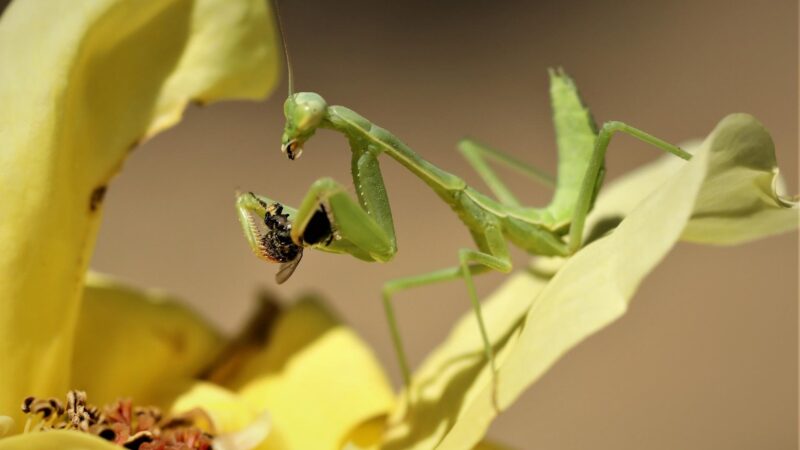
Praying mantis can eat as often as it can since it all depends on the food supply. Nonetheless, it can last for a long time, even without food. It likely hunts for food after four days of hunger.
What Does a Praying Mantis Drink?
In its natural habitat, a praying mantis obtains moisture from its food. It also drinks water droplets formed from dew or rain that sit on leaves found outdoors.
When keeping this insect as a pet, you can make this similar setting because it won’t drink directly from a cup. You’ll need a houseplant spray gun-like OFFIDIX Plant Mister Water Spray Bottle and Munyonyo Garden Pump Sprayer.
Mantises are sensitive to humidity so spray their cages a few times a week. But they need higher humidity when the period for molting comes. Hence, it’s helpful to spray more often.
But on normal days, it’s just right to create droplets that they can drink. After these droplets evaporate, it means another spraying is necessary.
How Much Does a Praying Mantis Eat a Day?

There’s no specific amount of what praying mantis eat in a day. It likely hunts for food after four days of hunger. When it catches prey, it continues eating until everything is stored in its foregut.
Some undigested food remains in the foregut until the time that this insect needs the nutrients.
When having a praying mantis as a pet, you have to directly feed it with flies or crickets. You may use your hand or pliers in doing it. As the mantis grows bigger, it means that it requires more food.
You can give it caterpillars or roaches and make sure that they consume enough food, or else they will perish.
Praying Mantis Diet and Eating Habits
Do Praying Mantis Eat Spiders?
Praying mantis eats spiders that are in small and medium sizes. They may not be able to defeat a large spider when they try to attack. Consequently, the table turns, and a large spider preys on the mantis.
Do Praying Mantis Eat Ants?
Ants are on the list of prey of praying mantis. However, the big mantises may not be interested in them due to their size. Small ants can’t satisfy the hunger of mature praying mantis. Vice versa, ants search for the eggs of praying mantis to feast on.
Do Praying Mantis Eat Plants?
As mentioned, the praying mantis is a carnivorous insect. It may seem that it can eat almost everything, but it doesn’t have an appetite for plants. Any leaves or plant matter don’t interest mantises. They’re an exemption to stick insects that like to munch on raspberry, rose, ficus, bramble, leatherleaf viburnum, and white oak.
Do Praying Mantis Eat Ladybugs?
Praying mantis and ladybugs are both beneficial in the garden as they eliminate pests that destroy plants. Ladybugs begin this role even when they’re in the pupa stage since they can eat around 400 aphids. A ladybug continues this job until it becomes an adult, and it can eat 5,000 aphids in its entire lifetime.
Just like praying mantis, ladybugs can also eat mites, leafhoppers, and other insects. However, the former thinks everything that comes its way is a meal. Therefore, praying mantis can eat ladybugs.
Do Praying Mantis Eat Cockroaches?
There are many cockroach species, and some of them can grow up to 3.5 inches long. They can fly and move fast, but their abilities are nothing to a praying mantis. The winner of the chase is the praying mantis, as it catches and eats cockroaches.
Do Praying Mantis Eat Birds?
Small birds will likely fall prey to praying mantis. The best example of this is the hummingbird. A praying mantis can be brutal after capturing a small bird. It would impale its skull to have access to brain tissues that it likes to consume. This is the usual activity of the Chinese mantis with the scientific name Tenodera aridifolia.
Do Praying Mantis Eat Grasshoppers?
Although the praying mantis belongs to the family of grasshoppers, it can still eat the latter. It’s because mantis is so predacious that it eats everything it sees.
Do Praying Mantis Eat Mosquitoes?
Mantises can eat everything that comes their way, so they can’t let flying mosquitoes pass.
How Do Praying Mantis Eat?
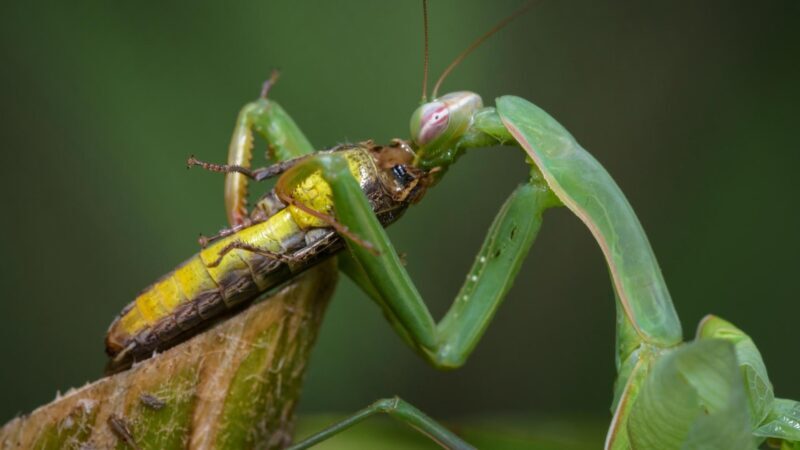
With its raptorial legs, a praying mantis will grasp and get hold of its prey. Then, the mantis will lift it and tighten its grasp so it can’t escape. Even though the prey puts a lot of effort into setting itself free, it’s not going to be productive once the mantis’ forelegs captured it.
The praying mantis proceeds to eat the prey once it’s locked in its forelegs. Consuming the flesh comes first then killing. Some portions of what it eats may not be digested right away, and they stay in the foregut for future use.
Why Do Female Praying Mantis Eats Male?
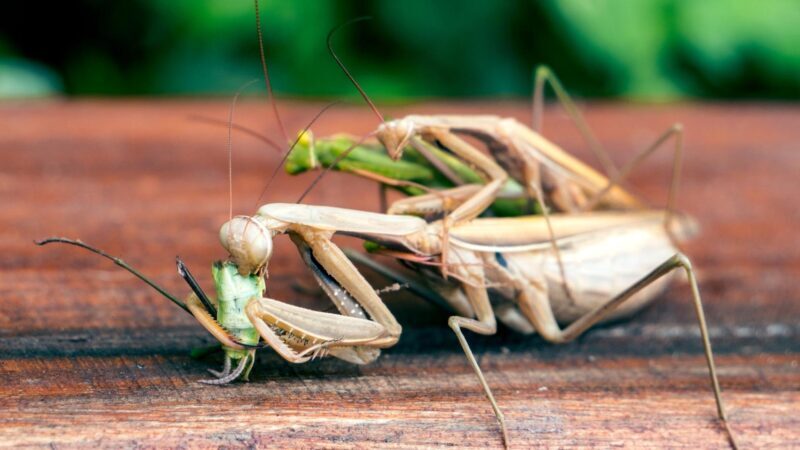
When talking about praying, there are some reasons why the female praying mantis eats its male counterpart.
First, the male becomes more effective in mating when decapitated. This is in connection with the use of nerve tissues in the abdomen when making copulatory movements.
Thus, mating can still go on with the intact abdomen. Unique to mantises, there’s a nerve center in the male’s brain that doesn’t allow mating if the female is not clasped yet.
Another reason is due to impulses. When a temperamental female is threatened or surprised, it immediately turns into the male and devours its head. Sexual cannibalism is common among other animals like scorpions and spiders.
To some praying mantis species, it’s a common ritual that doesn’t need to be reasonable. Female mantis will likely do it if there’s a food shortage.
What Eats Praying Mantis?
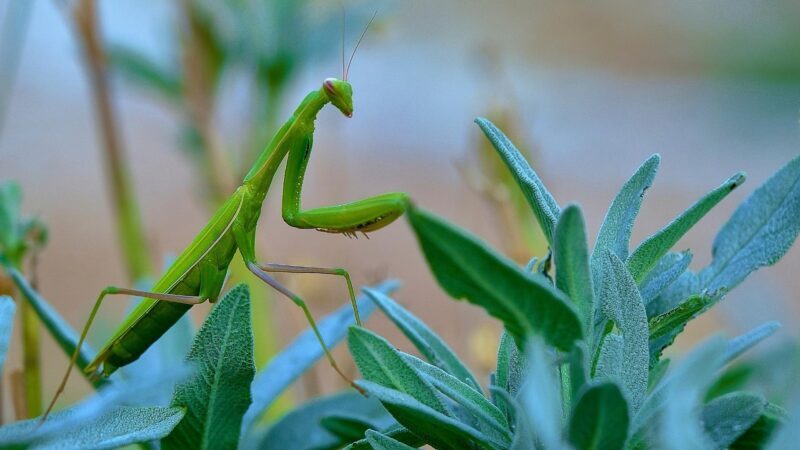
A praying mantis can lay 400 eggs in the wild. A warm temperature is necessary to hatch, which doesn’t happen in some cases. These are vulnerable as they are preyed upon by ants and wasps.
As the praying mantis grows as an adult, it becomes bigger, as well. In this stage, it aims to hunt animals that are fairly bigger than insects.
An adult mantis is after frogs, lizards, spiders, and wasps. These animals that they attempt on will sometimes be their predators. It can happen to a starving mantis as it forgets to practice silent hunting.
Exposing itself gives other animals the chance to easily catch it. Mammals that eat insects can also be one of the predators of praying mantis.
What Does Baby Praying Mantis Eat?
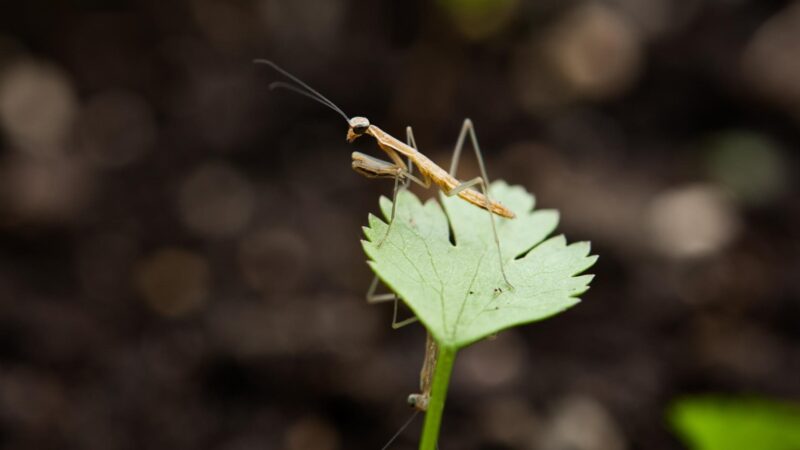
When the baby mantises are hatched from eggs, they’re not yet ready to hunt for food. The fit ones will eat their siblings. The baby praying mantis looks like the adult version but without wings.
Typically, they feed on aphids, fruit flies, and small insects. But they learn how to hunt before they reach adulthood. So the baby praying mantis can catch ants and flies.
Summary
A praying mantis is not only a carnivore but a ferocious one. It even eats its prey alive as its forelegs are great at locking animals within its reach. Just to feed its appetite, it can eat its sibling.
The female mantis also gnaws its mate’s head. Praying mantises are known for their drive to eat flesh, but they can stand not doing it for days. Even though they’re one of the stick insects, they don’t eat plants.
List of Sources
Praying Mantis – Stagmomantis Californica
Headless Males Make Good Lovers and Other Unusual Natural Histories